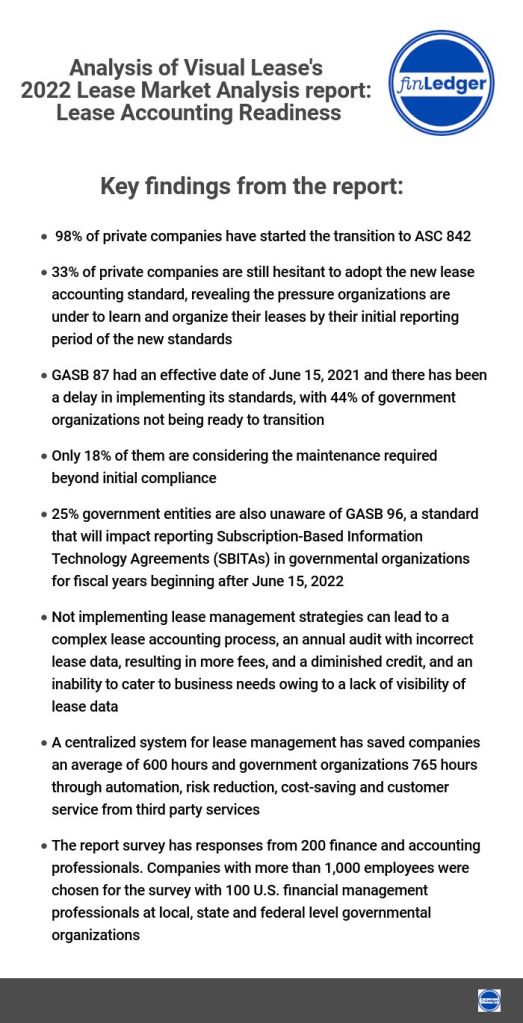Visual Lease, a lease optimization SaaS software provider, recently released a report on common lease accounting challenges and the benefits of strong lease management. The report found that 71% of organizations are unsure about how much their leases cost.

FinLedger spoke with Joe Fitzgerald, senior vice president of lease market strategy at Visual Lease to discuss the report and understand the implications of the new lease accounting standards.
This interview has been edited for length and clarity.
Q: Why was Visual Lease started?
A: Visual Lease is a lease accounting software solution that was developed about 25 years ago by Marc Betesh, who’s the chairman and founder.
Marc actually developed a solution initially to support another business, KBA Services, which is a forensic lease auditing service that’s still in business today. Then we created Visual Lease to support that business.
Q: How has the leasing market landscape changed since the pandemic?
A: When we think about leasing, historically, leasing from an accounting perspective was off balance sheet. So this new standard brought those leases on balance sheet, and it brought on real estate, as well as what we call non-real estate or equipment vehicle leases.
In the process of bringing those leases onto a company’s balance sheet, there was a level of scrutiny that started to be applied to those leases.
As a result, companies started to pull the leases in a more centralized manner in terms of how they manage them, and account for them. It’s fortunate that they did that, because as a result of the pandemic, the cost of leasing is one of the more significant costs that a corporation or company could add.
One of the byproducts of the new lease standard is because they had gone through the lease accounting exercise, they now have their leases in a centralized place for the first time. They are able to locate all their leases, and access the various clauses, as they were trying to negotiate with their landlords. As a result companies now have a better view to their lease portfolio.
Q: What are the impacts of the newly implemented lease accounting standards?
A: The Financial Accounting Standards Board governs accounting standards for publicly traded companies, as well as private commercial entities and nonprofits. They have the ASC 842, which is the new lease standard, which went into effect for most publicly traded companies in 2019.
If you think about where we are now in 2022, most publicly traded companies, if not all of them, have been through effectively three years of reporting under this new lease standard. So compare that to private commercial organizations first.
Initially, the private companies were supposed to go a year after the public company, so 2020, but as a result of some challenges in implementation and private filing, they weren’t ready. And then because of the pandemic, they delayed this standard a couple more years. So private companies are actually going through their initial adoption of ASC 842 this year.
On the flip side—public sector entities. They follow GASB, which is the Government Accounting Standards Board. They issued GASB 87, which is very similar to ASC 842 for the publicly traded and private corporations. That standard actually went into effect technically for a reporting period after June 15 of 2021. So a lot of GASB public sector entities are also in their first year of adoption.
The GASB public sector entities, as well as the private entities, had the benefit of the publicly traded companies going through it and doing it first because there were a lot of lessons learned, and best practices identified.
On the flip side, the government entities and the private companies aren’t necessarily as resourced as publicly traded companies. They are not typically as big, their portfolios are not as large, so in some ways, it could be even more challenging for them to adopt these new standards.
Q: What are some of the difficulties private companies and government entities face while adopting these new standards?
A: The first initial challenge is to gather all your contracts.
The second issue, and I call this the long pole in the tent, is data. You need to be able to read those contracts and extract the required data that’s going to help do the calculations to adopt the new lease accounting standard. You have to have resources that are available to do that; you have to have people who are knowledgeable about what to look for.
The third issue is that because you’re going from off balance sheet to on balance sheet, you have to create processes now that you did not necessarily have in the past. In the past, the finance department was not necessarily communicating regularly with the real estate department. Going forward, these cross-functional teams need to stay in constant communication.
The other thing to think about is that historically, before the adoption of the standard, many companies did the accounting for leases using Excel or a spreadsheet. Now, what they’re finding is that Excel is not necessarily sufficient.
The other issue too is that the standards are complex. So there’s an educational process that you need to go through to understand the lease accounting standards, not just in the finance group, but again, in those cross functional areas when it touches the standards such as real estate, such as procurement, such as IP, such as legal. It touches operations, it really touches the whole organization.
Q: What are some of the ways in which Visual Lease aids companies in gauging the cost of leases?
A: Visual Lease is not only a lease accounting solution, it’s also a lease administration management tool. When you capture all your lease data, and your leases in one system, you start to be able to do some things in terms of looking at the true cost of leasing.
So a lot of folks think it’s just the base rent — the monthly base rent that you pay, but there’s a lot of other ancillary costs that are associated with, say, a real estate lease. Common area maintenance charges, utility costs, there’s property taxes, and a lot of other costs that folks don’t focus on.
Now you can put them on to Visual Lease, and start to look at the other costs associated with leasing. An example is the end of term. Let’s say you’re in a real estate space for five years and you have a renewal option for another five years, but you need to give the landlord six months notice even to renew.
If you didn’t have a system and you missed that option — the notification period with the landlord — that could be very expensive, and the landlord doesn’t have to honor your renewal option.
So there are ways that a solution like Visual Lease helps the company better manage the cost of its leases, both in terms of the other costs associated with leasing, that aren’t as obvious as the base rent, as well as end-of-term options.
By having a solution like Visual Lease, the company is better able to manage and see those end of term options and make decisions at the appropriate timeframe.
Q: How does the lease optimization process work with the Visual Lease software?
A: Through technology you’re going to achieve some efficiencies just in terms of people costs, FTEs that are going to be used in the process of managing and accounting for your leases. So there’s an optimization there.
There’s a lot of costs associated with leasing, that without technology like a Visual Lease, you may not be aware of. We’ve seen situations where large customers have settled their leases into the system and started to realize they had multiple locations in one city.
They recognize that they’re leasing from 12 different small fleet managers around the globe, and they recognize when they get onto the system, they can consolidate that into just a few management companies and get better economics around those.
Q: Visual Lease recently appointed a new CEO, Robert Michlewicz. What is he bringing to the table?
A: Robert has a strong background in the software as a service technology sector. He has grown a business like Visual Lease. Although we’ve grown very well, we needed someone like Robert to get to the next level, and he has had that experience.
In other recent proptech news, Leste Group and SAR Apartment Capital, announced a $23.6 million acquisition of four multifamily properties in Ohio. Flexible leasing proptech company Landing also closed a $125M Series C led by the growth equity firm Delta-v Capital.
